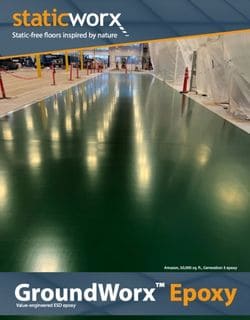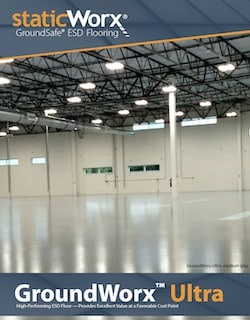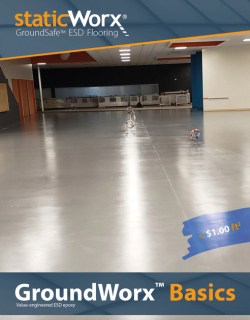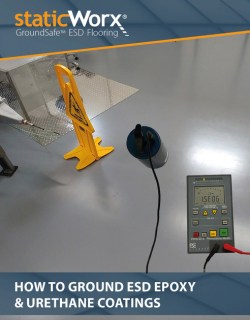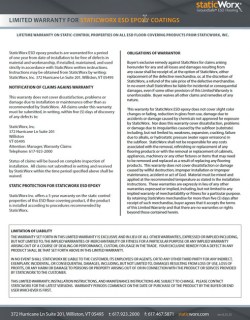Generation 3 Epoxy
ESD Floor Zaps Static Charge at Electronics Factory
Coatings Pro Magazine by Ben DuBose, March 4, 2019
 That was the conundrum for Extreme Engineering Solutions (X-ES), which manufactures and tests hardware for the embedded computing market at its headquarters just outside Madison, Wisconsin. Strong sales prompted plans for a new production facility in early 2018, but the nature of the products meant many standard floors would not work. Since static electricity results from friction between two materials, walking across the floor creates static buildup.
“A static charge can damage an electronic component like the ones they’re working on,” said Ron Puszynski, president of coatings contractor Concare Inc. “You can be at 10 V and damage some-thing, whereas you [as a person] can’t really feel a static electrical charge unless it gets up to about 1,500 V. You could be walking around all day long and zapping components without even knowing it.”
Fortunately for X-ES, Concare has installed electrostatic dissipative (ESD) floors since the mid-1980s. So when the client reached out to ESD flooring systems company ava for a solution, the manufacturer already had a trusted contractor ready to apply its system.
“It’s not the only thing that we do, but it’s one of those specialty niches that we’re very good at and have gotten a reputation for over a long period of time,” Puszynski said.
That was the conundrum for Extreme Engineering Solutions (X-ES), which manufactures and tests hardware for the embedded computing market at its headquarters just outside Madison, Wisconsin. Strong sales prompted plans for a new production facility in early 2018, but the nature of the products meant many standard floors would not work. Since static electricity results from friction between two materials, walking across the floor creates static buildup.
“A static charge can damage an electronic component like the ones they’re working on,” said Ron Puszynski, president of coatings contractor Concare Inc. “You can be at 10 V and damage some-thing, whereas you [as a person] can’t really feel a static electrical charge unless it gets up to about 1,500 V. You could be walking around all day long and zapping components without even knowing it.”
Fortunately for X-ES, Concare has installed electrostatic dissipative (ESD) floors since the mid-1980s. So when the client reached out to ESD flooring systems company ava for a solution, the manufacturer already had a trusted contractor ready to apply its system.
“It’s not the only thing that we do, but it’s one of those specialty niches that we’re very good at and have gotten a reputation for over a long period of time,” Puszynski said. Tilt Up Construction Challenges
One early challenge was handling the new concrete. For the 34,000-square-foot (3,158.7 m2) production area, X-ES opted for the on-site manufacturing of tilt-up wall panels. In this process, the concrete floor slab is poured first, followed by the tilt-up contractor framing out wall panels on the floor. From there, they spray a release agent and pour the concrete into forms. Anchors and lifting hooks are inserted into panels, which are then “tilted” into place. Moisture levels were first measured by the ESD contractor using a Rapid RH [relative humidity] concrete moisture test and shared with the material supplier to ensure the system had sufficient moisture tolerance. That tool came from Wagner Meters.
The choice for X-ES’s
production floor was the HB-97.2 epoxy line from StaticWorx.

“You can adjust the speed and size of media with these abrasive blast cleaning machines,” Puszynski said. “We used a very fine media and a very fast speed, and we went over the floor I think three times and crossed directions so that we never had any overlap lines that showed through.”
Another preliminary challenge related to the tilt-up design involved spot repairs and the filling of joints. “If you’re installing an ESD coating, you need to understand that you’re creating a conductive uniform surface,” Puszynski explained. “Every place that there was a control joint or a construction joint or any other type of break in the floor, we had to bridge all of those and fill in those joints and any cracks.” Crew members used a diamond-blade saw to clean out joints, then placed a backer rod into each joint so the sealant had a place to stop. Then, a two-component JF Polyurea filler was injected into each joint.
Wearing personal protective equipment (PPE) such as safety glasses, hard hats, steel-toed boots, and long pants and long-sleeved shirts in case of spills, the crew used a Blastrac 2-30D shot blasting unit for an abrasive blast cleaning. “This exposed the surface area, which aided in the release of any moisture that might be trapped underneath the surface,” Puszynski explained. To create a uniform surface, the crew took extra care when blasting.
“You can adjust the speed and size of media with these abrasive blast cleaning machines,” Puszynski said. “We used a very fine media and a very fast speed, and we went over the floor I think three times and crossed directions so that we never had any overlap lines that showed through.”
Another preliminary challenge related to the tilt-up design involved spot repairs and the filling of joints. “If you’re installing an ESD coating, you need to understand that you’re creating a conductive uniform surface,” Puszynski explained. “Every place that there was a control joint or a construction joint or any other type of break in the floor, we had to bridge all of those and fill in those joints and any cracks.” Crew members used a diamond-blade saw to clean out joints, then placed a backer rod into each joint so the sealant had a place to stop. Then, a two-component JF Polyurea filler was injected into each joint.
Conductive Coating
The crew waited for the last possible opportunity to install the ESD coating system to allow for maximum dryness of the new, bare concrete. The choice for X-ES’s production floor was the HB-97.2 epoxy line from StaticWorx, which includes both an epoxy primer and polyurethane topcoat. Using 18-inch (45.7 cm) rollers, the moisture-tolerant primer was applied over consecutive days in two coats at ~12 mils (304.8 microns) of wet film thickness (WFT) each time. No additional PPE, such as respirators, was needed for the crew, since the coatings are extremely low in volatile organic compounds (VOCs).
“We put in two coats of the primer material,” Puszynski said. “The fist coat, we add a bit of thinner to it to increase the viscosity so that it penetrates better. You want to get that stuff into the concrete as far as you can. Then the second layer creates a uniform plane all the way across the floor. That gives you a nice, uniform surface to apply the static-controlled topcoat.”
Prior to topcoating, Concare installed ESD grounding straps in locations designated by X-ES and their electrical contractor. Then, the StaticWorx 97.2 ESD Topcoat was applied as the system’s finishing layer at an average of 6 mils (152.4 microns) WFT. In that final coating, Concare added very fine, clear glass beads to provide added safety texture for the floor.
Rave Reviews
Within 10 days, the crew successfully installed the entire ESD flooring system, which allowed X-ES to remain on schedule to open its new production area. “The results were even better than expected,” Puszynski said. “When the project is completed, a week or two later, the manufacturer comes in and tests the floor for compliance with ESD products. They test the entire floor. They came in and did their testing, and they said they had not seen a floor produce as uniform a consistent a static discharge finish as this one. The ESD properties are somewhat dependent on the thickness of the coating application, and this was applied so uniformly that they said there was virtually zero variation.”
While the floor ultimately looked attractive as well, the contractor says its success came from intense focus on performance. “This is like a piece of production equipment,” Puszynski said of the floor. “The customer wouldn’t do it just to make it pretty. They do it for a specific, highly critical part of their application. They’re looking for performance properties, as opposed to decorative or a glossy finish. That’s really the key. That’s why they’re buying it.”
The results were even better than expected.
The extra charge from Concare’s crew ensured the floor wouldn’t have one!
GroundWorx Ultra Epoxy














HB97.2
Moisture Tolerant Primer-A
HB97.2
Moisture Tolerant Primer-B
HB97.2
Primer Colorant
HB97.2
ANSI/ESD 20.20 Compliant Top Coat A
HB97.2
ANSI/ESD 20.20 Compliant Top Coat B
HB97.2
Top Coat Colorant
HB97.2
Slip Resistant Aggregate Additive
Learn about GroundWorx Ultra.
Download the GroundWorx Ultra brochure.
Get in Touch
The form below will help us better understand your needs and get you as quickly as possible to the right person. We look forward to helping you solve your static problem!
You can expect a response within 24 hours. For faster service, please give us a call: 617-923-2000
"*" indicates required fields
Visit our privacy policy to find out how we process data.

StaticWorx high-performance static-control floors protect electronic components, explosives, and high-speed computers from damage caused by static electricity. ESD flooring is part of a system. Choices should always be based on objective, researched evidence. When you partner with us, we look at all possible items that may need to integrate with the floor, and, focusing on your goals and objectives, help you find the right floor for your application.


